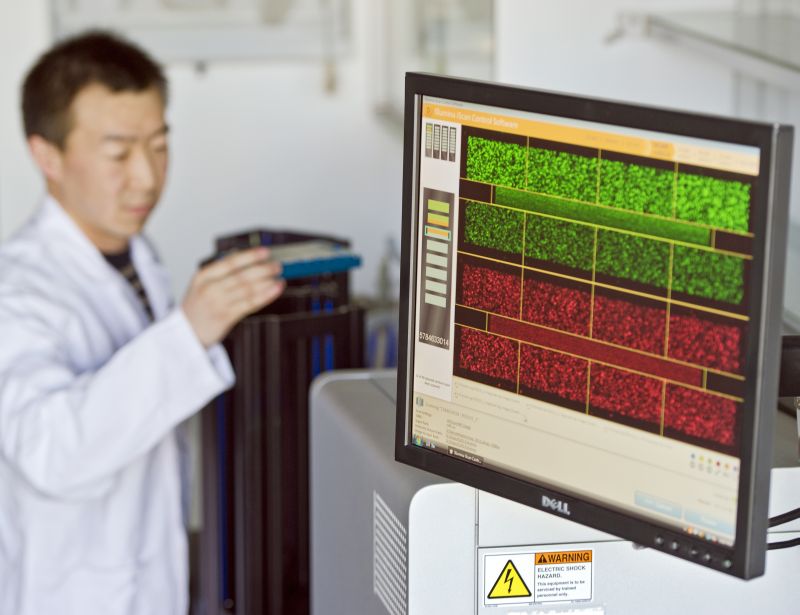DNA analysis helps prevent disease in animals
Breeding by genetic profile

Prof. Ruedi Fries and Hubert Pausch from Technische Universität München (TUM) have zoned in on a natural protection mechanism: A small proportion of Bavarian Fleckvieh cattle have dark pigmentation in the skin around their eyes and on their eyelids. Previous investigations have shown that this pigmentation gives the animals protection against eye tumors. “The search for the responsible gene segments was like looking for a needle in a haystack,” admitted animal researcher Ruedi Fries. This is because the color and size of the protective rings around the eyes (ambilateral circumocular pigmentation) are determined by a large number of DNA segments, maybe even as many as several thousand.
What the “genetic fingerprint” reveals
The researchers were able to identify twelve DNA segments in the inheritance pattern of the eye rings, which explain up to 57 percent of the heritability. “As soon as a calf is born, we can predict with a higher accuracy than before, whether its progeny will have the protective eye pigmentation,” explained Prof. Fries. This knowledge could be a major advantage for breeders in countries with high levels of UV radiation. “Genetic fingerprinting” of breeding bulls has been standard practice for several years already. The method can now be used to check for the inheritance pattern of the protective eye pigmentation – giving a head-start when it comes to selecting suitable breeding animals. Fries is convinced that, “the number of animals susceptible to eye tumors can be reduced in the short term.”
To decode the inheritance pattern of the eye pigmentation, the researchers combined the use of statistical prediction models with the very latest DNA analysis methods. Their first task was to create “genetic fingerprints” for individual breeding bulls. This involved recording several hundred thousand tiny variations in the DNA strand for each and every animal. Taken as a whole, these produce a unique profile. The researchers collected those “fingerprints” from around 3,400 bulls.
Predicting breeding success
With the help of statistical methodologies, the researchers then combined the DNA profiles with information on the physical traits of the progeny of each breeding bull in this case, the pigmentation surrounding the eyes. By combining the two statistics, it is possible to assess the probability of inheriting the dark pigmentation. This also applies to young animals that are a long way from being sexually mature.
The “genomic selection” method used by Ruedi Fries and Hubert Pausch can be used for more than just the selection of suitable breeding bulls. It is increasingly being used to support maize cultivation and chicken breeding. This work is being carried out in the “Synbreed” research cluster, where animal researchers Fries and Pausch collaborate with plant researchers and bioinformatics experts. The common goal here, too, is to make breeding success predictable. As Prof. Fries explains, “Knowing more about the effects of genes and their defects opens up entirely new possibilities when it comes to breeding.”
Further information:
DNA segments near these twelve genes are particularly relevant for pigmentation around the eyes: MCM6, PAX3, ERBB3, KITLG, LEF1, DKK2, KIT, CRIM1, ATRN, GSDMC, MITF and NBEAL.
The Synergistic Plant and Animal Breeding (Synbreed) competence cluster is working on genomic selection for a number of breeding and cultivation objectives for maize, chickens and cattle. The research network deploys the latest technologies, bundling the know-how of outstanding researchers from the disciplines of agricultural science, molecular biology, bioinformatics and human medicine. The cluster brings together experts from universities, non-university partners and industry. Synbreed is funded by the German Federal Ministry for Education and Research (BMBF) as part of the “Competence Networks for Agricultural and Nutrition Research” initiative.
www.synbreed.tum.de
Publication:
Hubert Pausch, Xiaolong Wang, Simone Jung, Dieter Krogmeier, Christian Edel, Reiner Emmerling, Kay-Uwe Götz, Ruedi Fries, 2012: Identification of QTL for UV-Protective Eye Area Pigmentation in Cattle by Progeny Phenotyping and Genome-Wide Association Analysis, doi:10.1371/journal.pone.0036346
http://www.plosone.org/article/info%3Adoi%2F10.1371%2Fjournal.pone.0036346
Contact:
Technische Universität München
Chair of Animal Breeding
Prof. Ruedi Fries / M. Sc. Hubert Pausch
T: 08161 71 3228 / 08161 71 3743
E: Ruedi.Fries@tum.de / Hubert.Pausch@tz.agrar.tu-muenchen.de
Technical University of Munich
Corporate Communications Center
- Undine Ziller
- ziller@zv.tum.de
- presse@tum.de
- Teamwebsite